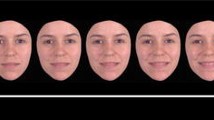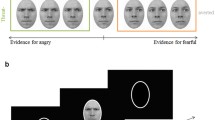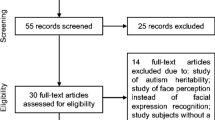Abstract
Determining the integrity of emotion recognition in autistic spectrum disorder is important to our theoretical understanding of autism and to teaching social skills. Previous studies have reported both positive and negative results. Here, we take a formal meta-analytic approach, bringing together data from 48 papers testing over 980 participants with autism. Results show there is an emotion recognition difficulty in autism, with a mean effect size of 0.80 which reduces to 0.41 when a correction for publication bias is applied. Recognition of happiness was only marginally impaired in autism, but recognition of fear was marginally worse than recognition of happiness. This meta-analysis provides an opportunity to survey the state of emotion recognition research in autism and to outline potential future directions.



Similar content being viewed by others
References
Adams, R., Ambady, N., Macrae, C., & Kleck, R. (2006). Emotional expressions forecast approach-avoidance behavior, motivation and emotion (pp. 177–186). The Netherlands: Springer.
Adolphs, R. (2008). Fear, faces, and the human amygdala. Current Opinion in Neurobiology, 18, 166–172.
Adolphs, R., Gosselin, F., Buchanan, T. W., Tranel, D., Schyns, P., & Damasio, A. R. (2005). A mechanism for impaired fear recognition after amygdala damage. Nature, 433, 68–72.
Adolphs, R., Tranel, D., Hamann, S., Young, A. W., Calder, A. J., Phelps, E. A., et al. (1999). Recognition of facial emotion in nine individuals with bilateral amygdala damage. Neuropsychologia, 37, 1111–1117.
Anderson, A. K., Spencer, D. D., Fulbright, R. K., & Phelps, E. A. (2000). Contribution of the anteromedial temporal lobes to the evaluation of facial emotion. Neuropsychology, 14, 526–536.
Ashwin, C., Chapman, E., Colle, L., & Baron-Cohen, S. (2006). Impaired recognition of negative basic emotions in autism: A test of the amygdala theory. Social Neuroscience, 1, 349–363.
Baron-Cohen, S., Jolliffe, T., Mortimore, C., & Robertson, M. (1997). Another advanced test of theory of mind: Evidence from very high functioning adults with autism or Asperger syndrome. Journal of Child Psychology and Psychiatry, 38, 813–822.
Baron-Cohen, S., Ring, H. A., Bullmore, E. T., Wheelwright, S., Ashwin, C., & Williams, S. C. R. (2000). The amygdala theory of autism. Neuroscience and Biobehavioral Reviews, 24, 355–364.
Baron-Cohen, S., Spitz, A., & Cross, P. (1993). Do children with autism recognise surprise? A research note. Cognition and Emotion, 7, 507–516.
Begeer, S., Koot, H. M., Rieffe, C., Meerum Terwogt, M., & Stegge, H. (2008). Emotional competence in children with autism: Diagnostic criteria and empirical evidence. Developmental Review, 28, 342–369.
Boraston, Z., Blakemore, S. J., Chilvers, R., & Skuse, D. (2007). Impaired sadness recognition is linked to social interaction deficit in autism. Neuropsychologia, 45, 1501–1510.
Braverman, M., Fein, D., Lucci, D., & Waterhouse, L. (1989). Affect comprehension in children with pervasive developmental disorders. Journal of Autism and Developmental Disorders, 19, 301–316.
Burack, J., Iarocci, G., Flanagan, T., & Bowler, D. (2004). On mosaics and melting pots: Conceptual considerations of comparison and matching strategies. Journal of Autism and Developmental Disorders, 34, 65–73.
Camras, L. A., & Shutter, J. M. (2010). Emotional facial expressions in infancy. Emotion Review, 2, 120–129.
Castelli, F. (2005). Understanding emotions from standardized facial expressions in autism and normal development. Autism, 9, 428–449.
Celani, G., Battacchi, M. W., & Arcidiacono, L. (1999). The understanding of the emotional meaning of facial expressions in people with autism. Journal of Autism and Developmental Disorders, 29, 57–66.
Charman, T., Swettenham, J., Baron-Cohen, S., Cox, A., Baird, G., & Drew, A. (1998). An experimental investigation of social-cognitive abilities in infants with autism: Clinical implications. Infant Mental Health Journal, 19, 260–275.
Clark, T. F., Winkielman, P., & McIntosh, D. N. (2008). Autism and the extraction of emotion from briefly presented facial expressions: Stumbling at the first step of empathy. Emotion, 8, 803–809.
Cohen, J. (1988). Statistical power analysis for the behavioral sciences (2nd edn). Academic Press: Routledge.
Corbett, B. A., Carmean, V., Ravizza, S., Wendelken, C., Henry, M. L., Carter, C., et al. (2009). A functional and structural study of emotion and face processing in children with autism. Psychiatry Research: Neuroimaging, 173, 196–205.
Corden, B., Chilvers, R., & Skuse, D. (2008). Avoidance of emotionally arousing stimuli predicts social-perceptual impairment in Asperger’s syndrome. Neuropsychologia, 46, 137–147.
Da Fonseca, D., Santos, A., Bastard-Rosset, D., Rondan, C., Poinso, F., & Deruelle, C. (2009). Can children with autistic spectrum disorders extract emotions out of contextual cues? Research in Autism Spectrum Disorders, 3, 50–56.
Dalton, K. M., Nacewicz, B. M., Johnstone, T., Schaefer, H. S., Gernsbacher, M. A., Goldsmith, H. H., et al. (2005). Gaze fixation and the neural circuitry of face processing in autism. Nature, 8, 519–526.
Davies, S., Bishop, D., Manstead, A. S. R., & Tantam, D. (1994). Face perception in children with autism and Asperger’s syndrome. Journal of Child Psychology and Psychiatry, 35, 1033–1057.
Dickersin, K. (1990). The existence of publication bias and risk factors for its occurrence. JAMA, 263, 1385–1389.
Dimberg, U., & Petterson, M. (2000). Facial reactions to happy and angry facial expressions: Evidence for right hemisphere dominance. Psychophysiology, 37, 693–696.
Dimberg, U., & Thunberg, M. (1998). Rapid facial reactions to emotional facial expressions. Scandinavian Journal of Psychology, 39, 39–45.
Duval, S., & Tweedie, R. (2000). A nonparametric “Trim and Fill” method of accounting for publication bias in meta-analysis. Journal of the American Statistical Association, 95, 89–98.
Egger, M., Smith, G. D., & Phillips, A. N. (1997a). Meta-analysis: Principles and procedures. BMJ, 315, 1533–1537.
Egger, M., Smith, G. D., Schneider, M., & Minder, C. (1997b). Bias in meta-analysis detected by a simple, graphical test. BMJ, 315, 629–634.
Ekman, P. (1992). Facial expressions of emotion: An old controversy and new findings. Philosophical Transactions of the Royal Society of London. Series B, Biological sciences, 335, 63–69.
Ekman, P. (2004). Emotions revealed: Recognizing faces and feelings to improve communication and emotional life. New York: Owl Books.
Ekman, P., & Friesen, W. V. (1976). Measuring facial movement. Journal of Nonverbal Behavior, 1, 56–75.
Fein, D., Lueci, D., Braverman, M., & Waterhouse, L. (1992). Comprehension of affect in context in children with pervasive developmental disorders. Journal of Child Psychology and Psychiatry, 33, 1157–1162.
Gepner, B., Gelder, B. D., & Schonen, S. D. (1996). Face processing in autistics: Evidence for a generalised deficit? Child Neuropsychology, 2, 123–139.
Golan, O., Ashwin, E., Granader, Y., McClintock, S., Day, K., Leggett, V., et al. (2010). Enhancing emotion recognition in children with autism spectrum conditions: An intervention using animated vehicles with real emotional faces. Journal of Autism and Developmental Disorders, 40, 269–279.
Green, S. (2005). Systematic reviews and meta-analysis. Singapore Medical Journal, 46, 270–273. (quiz 274).
Gurevitch, J., & Hedges, L. V. (1999). Statistical issues in ecological meta-analyses. Ecology, 80, 1142–1149.
Hariri, A. R., Bookheimer, S. Y., & Mazziotta, J. C. (2000). Modulating emotional responses: Effects of a neocortical network on the limbic system. NeuroReport, 11, 43–48.
Harms, M., Martin, A., & Wallace, G. (2010). Facial emotion recognition in autism spectrum disorders: A review of behavioral and neuroimaging studies. Neuropsychology Review, 20, 290–322.
Hedges, L. V. (1981). Distribution theory for glass’s estimator of effect size and related estimators. Journal of Educational and Behavioral Statistics, 6, 107–128.
Herba, C., & Phillips, M. (2004). Development of facial expression recognition from childhood to adolescence: Behavioural and neurological perspectives. Journal of Child Psychology and Psychiatry, 45, 1185–1198.
Hobson, R. P. (1986a). The autistic child’s appraisal of expressions of emotion. Journal of Child Psychology and Psychiatry, 27, 321–342.
Hobson, R. P. (1986b). The autistic child’s appraisal of expressions of emotion: A further study. Journal of Child Psychology and Psychiatry, 27, 671–680.
Hobson, R. P., Ouston, J., & Lee, A. (1988). Emotion recognition in autism: Coordinating faces and voices. Psychological Medicine, 18, 911–923.
Hopkins, I. M., Gower, M. W., Perez, T. A., Smith, D. S., Amthor, F. R., Wimsatt, F. C., & Biasini, F. J. (2011). Avatar assistant: Improving social skills in students with an ASC through a computer-based intervention. Journal of Autism Development Disorder, 41(11), 1543–1555.
Howard, M. A., Cowell, P. E., Boucher, J., Brooks, P., Mayes, A., Farrant, A., et al. (2000). Convergent neuroanatomical and behavioural evidence of an amygdala hypothesis of autism. NeuroReport, 11, 2931–2935.
Humphreys, K., Minshew, N., Leonard, G. L., & Behrmann, M. (2007). A fine-grained analysis of facial expression processing in high-functioning adults with autism. Neuropsychologia, 45, 685–695.
Jarrold, C., & Brock, J. (2004). To match or not to match? Methodological issues in autism-related research. Journal of Autism and Developmental Disorders, 34, 81–86.
Johnson, M. H., Halit, H., Grice, S. J., & Karmiloff-Smith, A. (2002). Neuroimaging of typical and atypical development: A perspective from multiple levels of analysis. Development and Psychopathology, 14, 521–536.
Jones, C. R. G., Pickles, A., Falcaro, M., Marsden, A. J. S., Happe, F., Scott, S. K., et al. (2011). A multimodal approach to emotion recognition ability in autism spectrum disorders. Journal of Child Psychology and Psychiatry, 52, 275–285.
Joseph, R. M., & Tanaka, J. (2003). Holistic and part-based face recognition in children with autism. Journal of Child Psychology and Psychiatry, 44, 529–542.
Kanner, L. (1943). Autistic disturbances of affective contact. Nervous Child, 2, 217–250.
Klin, A., Jones, W., Schultz, R., Volkmar, F., & Cohen, D. (2002). Visual fixation patterns during viewing of naturalistic social situations as predictors of social competence in individuals with autism. Archives of General Psychiatry, 59, 809–816.
Lacroix, A., Guidetti, M., Rogé, B., & Reilly, J. (2009). Recognition of emotional and nonemotional facial expressions: A comparison between Williams syndrome and autism. Research in Developmental Disabilities, 30, 976–985.
Law Smith, M. J., Montagne, B., Perrett, D. I., Gill, M., & Gallagher, L. (2010). Detecting subtle facial emotion recognition deficits in high-functioning autism using dynamic stimuli of varying intensities. Neuropsychologia, 48, 2777–2781.
Lopez, B., Donnelly, N., Hadwin, J., & Leekam, S. (2004). Face processing in high-functioning adolescents with autism: Evidence for weak central coherence. Visual Cognition, 11, 673–688.
Lord, C., & Jones, R. M. (2012). Annual research review: Re-thinking the classification of autism spectrum disorders. Journal of Child Psychology and Psychiatry, 53(5), 490–509.
Loveland, K. A., Bachevalier, J., Pearson, D. A., & Lane, D. M. (2008). Fronto-limbic functioning in children and adolescents with and without autism. Neuropsychologia, 46, 49–62.
Mandy, W. P. L., Charman, T., & Skuse, D. H. (2012). Testing the construct validity of proposed criteria for DSM-5 autism spectrum disorder. Journal of the American Academy of Child and Adolescent Psychiatry, 51(1), 41–50.
Mervis, C. B., & Klein-Tasman, B. P. (2004). Methodological issues in group-matching designs: Alpha levels for control variable comparisons and measurement characteristics of control and target variables: Research methodology-matching. Journal of Autism and Developmental Disorders, 34, 7–17.
Moses, L. J., Baldwin, D. A., Rosicky, J. G., & Tidball, G. (2001). Evidence for referential understanding in the emotions domain at twelve and eighteen months. Child Development, 72, 718–735.
Neumann, D., Spezio, M. L., Piven, J., & Adolphs, R. (2006). Looking you in the mouth: Abnormal gaze in autism resulting from impaired top-down modulation of visual attention. Social Cognitive and Affective Neuroscience, 1, 194–202.
Olsson, A., Nearing, K. I., & Phelps, E. A. (2007). Learning fears by observing others: The neural systems of social fear transmission. Social Cognitive and Affective Neuroscience, 2, 3–11.
Ozonoff, S., Pennington, B., & Rogers, S. (1990). Are there emotion perception deficits in young autistic children? Journal of Child Psychology and Psychiatry and Allied Disciplines, 31, 343–361.
Pelphrey, K. A., Sasson, N. J., Reznick, J. S., Paul, G., Goldman, B. D., & Piven, J. (2002). Visual Scanning of Faces in Autism. Journal of Autism and Developmental Disorders, 32, 249–261.
Phan, K. L., Wager, T., Taylor, S. F., & Liberzon, I. (2002). Functional neuroanatomy of emotion: A meta-analysis of emotion activation studies in PET and fMRI. NeuroImage, 16, 331–348.
Phillips, M. L., Drevets, W. C., Rauch, S. L., & Lane, R. (2003). Neurobiology of emotion perception I: The neural basis of normal emotion perception. Biological Psychiatry, 54, 504–514.
Piggot, J., Kwon, H., Mobbs, D., Blasey, C., Lotspeich, L., Menon, V., et al. (2004). Emotional attribution in high-functioning individuals with autistic spectrum disorder: A functional imaging study. Journal of the American Academy of Child and Adolescent Psychiatry, 43, 473–480.
Prinz, J. J. (2004). Which emotions are basic? In D. Evans & P. Cruse (Eds.), Emotion, evolution and rationality. Oxford: Oxford University Press.
Rosenberg, M. S., Adams, D. C., & Gurevitch, J. (2007). MetaWin: Statistical software for meta-analysis 2.0.
Russell, J. A., Bachorowski, J.-A., & Fernandez-Dols, J.-M. (2003). Facial and vocal expressions of emotion. Annual Review of Psychology, 54, 329–349.
Schwarzer, G. (2007). Meta: An R package for meta-analysis, R News, 7(3), 40–45.
Smith, M. L., Cottrell, G. W., Gosselin, F., & Schyns, P. G. (2005). Transmitting and decoding facial expressions. Psychological Science, 16, 184–189.
Spezio, M., Adolphs, R., Hurley, R., & Piven, J. (2007). Abnormal use of facial information in high-functioning autism. Journal of Autism and Developmental Disorders, 37, 929–939.
Tantam, D., Monaghan, L., Nicholson, H., & Stirling, J. (1989). Autistic children’s ability to interpret faces: A research note. Journal of Child Psychology and Psychiatry, 30, 623–630.
Teunisse, J. P., & de Gelder, B. (2001). Impaired categorical perception of facial expressions in high-functioning adolescents with autism. Child Neuropsychology (Neuropsychology, Development and Cognition: Section C) 7, 1–14.
Thomas, M. S. C., Annaz, D., Ansari, D., Scerif, G., Jarrold, C., & Karmiloff-Smith, A. (2009). Using developmental trajectories to understand developmental disorders. Journal of Speech Language and Hearing Research, 52, 336–358.
Tracy, J., Robins, R., Schriber, R., & Solomon, M. (2011). Is emotion recognition impaired in individuals with autism spectrum disorders? Journal of Autism and Developmental Disorders, 41, 102–109.
Van den Noortgate, W., & Onghena, P. (2006). Analysing repeated measures data in cognitive research: A comment on regression coefficient analyses. The European Journal of Cognitive Psychology, 18, 937–952.
Van Der Geest, J. N., Kemner, C., Verbaten, M. N., & Van Engeland, H. (2002). Gaze behavior of children with pervasive developmental disorder toward human faces: A fixation time study. Journal of Child Psychology and Psychiatry, 43, 669–678.
Walker-Andrews, A. S. (1998). Emotions and social development: Infants’ recognition of emotions in others. Pediatrics, 102, e1268.
Wallace, S., Coleman, M., & Bailey, A. (2008). An investigation of basic facial expression recognition in autism spectrum disorders. Cognition and Emotion, 22, 1353–1380.
Weeks, S. J., & Hobson, R. P. (1987). The salience of facial expression for autistic children. Journal of Child Psychology and Psychiatry, 28, 137–152.
Whalen, P. J. (2007). The uncertainty of it all. Trends in Cognitive Sciences, 11, 499–500.
Acknowledgments
We thank Uta Frith, Tony Atkinson and Anneli Kylliainen for helpful comments on this manuscript, and Zoran Uljarevic for help preparing parts of the tables.
Author information
Authors and Affiliations
Corresponding author
Electronic supplementary material
Below is the link to the electronic supplementary material.
Rights and permissions
About this article
Cite this article
Uljarevic, M., Hamilton, A. Recognition of Emotions in Autism: A Formal Meta-Analysis. J Autism Dev Disord 43, 1517–1526 (2013). https://doi.org/10.1007/s10803-012-1695-5
Published:
Issue Date:
DOI: https://doi.org/10.1007/s10803-012-1695-5




